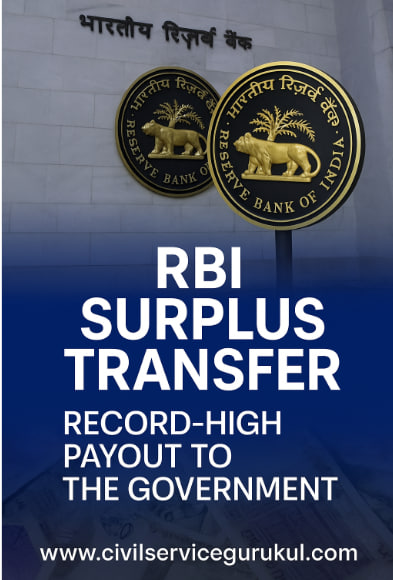RBI Surplus Transfer: A Record-High Payout to the Government

The Business Case for Green Human Resource Management- Current affairs for UPSC Commerce Optional Paper 2
April 26, 2025
Logistics Sector in India: Enhancing Efficiency and Reducing Costs
May 14, 2025RBI Surplus Transfer: A Record-High Payout to the Government
Why in the News?
The Reserve Bank of India (RBI) has approved the highest-ever surplus transfer of ₹2.11 lakh crore to the government for FY24, more than twice the previous year’s transfer of ₹86,416 crore.
Understanding the Surplus Transfer
The sharp increase in the surplus transfer can be attributed to higher income from forex holdings, among other factors. While this surplus pertains to the fiscal year 2023-24, its impact will reflect in the government’s accounts for the fiscal year 2024-25.
What is RBI’s Surplus?
The surplus refers to the excess of income over expenditure. The RBI operates with a highly efficient cost structure, with its total expenditure amounting to only one-seventh of its total net interest income, thereby generating a significant surplus.
Legal Framework for Surplus Transfer
- RBI Act, 1934:
- Section 48 of the RBI Act exempts the central bank from income tax or super tax on its earnings.
- Section 47 mandates that any profits generated by the RBI must be transferred to the Central Government, after making necessary provisions for Contingency Fund (CF) and Asset Development Fund (ADF).
- Committee Recommendations:
- Earlier, the RBI retained a significant portion of its surplus for CF and ADF.
- Following the Malegam Committee (2013) recommendations, the surplus transfer to the government was increased.
- Other committees formed to determine an optimal surplus transfer include:
- V Subrahmanyam Committee (1997)
- Usha Thorat Committee (2004)
- Y.H. Malegam Committee (2013)
- Bimal Jalan Committee (2018)
- Economic Capital Framework (ECF):
- This framework defines the methodology for determining the level of risk provisions and profit distribution under Section 47 of the RBI Act.
- The Bimal Jalan Committee (2018) revised the ECF, setting surplus transfer rules based on:
- Realized Equity (Contingency Fund): Maintained within a range of 6.5% to 5.5% of the RBI’s balance sheet. Any excess is transferred to the government.
- Economic Capital (CGRA – Currency and Gold Revaluation Account): Should be maintained in the range of 20.8% to 25.4% of the balance sheet, with the remainder being transferred to the government.
- The RBI’s Central Board has decided to keep the realized equity level at 5.5%.
Impact of Surplus Transfer on Government Finances
- Helps Reduce Fiscal Deficit:
- This transfer will aid the government in meeting its fiscal deficit target of 5.1% for FY 2024-25.
- Strengthens Revenue Collections:
- The surplus acts as a key source of non-tax revenue, enabling greater government spending to fuel economic growth.
- Reduces Government Borrowing:
- The transfer may reduce gross borrowing for FY25 by up to ₹1 trillion.
- Lower borrowing reduces the supply of government securities (G-Secs), leading to lower yields and reduced borrowing costs.
- Leads to Lower Interest Rates:
- A fall in government bond yields due to surplus transfer makes borrowing cheaper for businesses and individuals.
Conclusion
RBI’s surplus transfers have often been debated concerning the adequacy of contingency reserves and the autonomy of the central bank. However, this record-high transfer significantly contributes to the government’s fiscal planning and provides additional resources for public expenditure and development projects. By boosting liquidity and government spending, the surplus transfer can stimulate economic growth and sectoral revival, making it a crucial aspect of India’s financial ecosystem.


